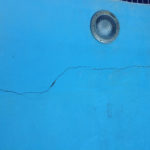Identifying Structural Or Surface Cracks In Your Pool
Swimming pool cracks are often on the surface of the pool body in the plaster coat, and do not run all the way through the pool body itself.
The majority of in-ground pools are constructed of 6 to 8 inches of gunite or shotcrete, a concrete type of material, spayed over rebar steel reinforcement. Contractors often refer to in-ground gunite and shotcrete pools as concrete pools, verses in-ground fiberglass or vinyl lined in-ground pools.
The top edge of a concrete pool body usually has an extra wide area (about 12 inches) of gunite or shotcrete that adds more strength to the top rim of the pool shell; this top area is called a bond beam. Overall, in-ground concrete pools are usually very strong and last for many years, especially with proper maintenance.
Structural cracks v. surface cracking
Not all pool cracks mean that the pool is leaking, i.e shrinkage cracks are normal; they are shallow and just part of the curing process that occurs when the pool is first shot with gunite or shotcrete.If a crack is a structural crack, there is a pretty good chance that the pool is leaking or will eventually leak. These cracks occur in the shell of the pool and may appear in various locations. The cracking may be vertical or horizontal or on the sides or bottom of the pool. The majority of structural cracks running through the concrete (gunite or shotcrete) will also be mirrored through the plaster coating or the tile area over the bond beam. Pools that are significantly out of level and also has cracking, tells you that problems exist; potentially structural cracking and leaks.
Surface cracking is basically observed in the plaster and for the most part is not a leak issue. These surface cracks are normally thought of as maintenance or repair types of issue. As a homeowner or buyer, it wise not to jump conclusions that surface cracks actually runs through the shell of the pool and that it’s leaking.
Three main causes for pool cracks
1. Improper engineering and design
If a pool is not properly designed and engineered, then the likely hood of the shell to crack increases. Often the first flaw of engineering a pool is failure to test the soils and engineer the pool based on the soil load bearing capacity and stability. Soils with a clay content, usually called expansive soils, are one of the more problematic types of soils. Additionally, poor design of the areas around the pool plays a part in the overall picture; retaining walls and the concrete deck areas around a pool are a perfect example.
2. Poor workmanship
Failure to follow the construction plans when building the pool or taking shortcuts is a large part of why a pool will crack. Simple things like adding too much water to the gunite or shotcrete when spraying it on the rebar or failure to adequately tie the rebar in place when placing the rebar, may cause cracks. Even not keeping the pool sufficiently moist after the concrete is sprayed on, especially in hot climates or hot days will cause cracking.
3. Soils issues
Soil issues are another major reason for a pool to crack. If the contractor left uncompacted soil when digging the pool hole and then built the pool on this poorly compacted soil, it may result in cracking. Soil movement, especially on hillsides, likewise may cause cracking; on flat lots with expansive soils or even earthquakes can cause a pool to crack.
Bottom Line
Overall in-ground concrete gunite and shotcrete pools hold up well for many years. The majority of cracks that homeowners and buyers see are in the plaster and do not penetrate through the entire pool shell or body. These types of cracks are generally considered a maintenance issues but should not be ignored.

